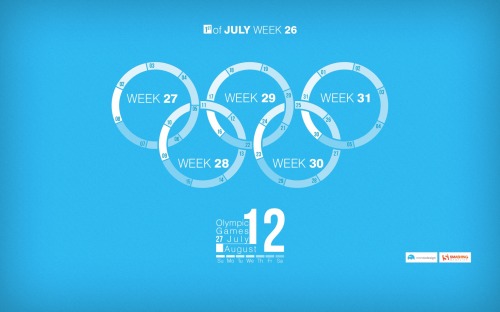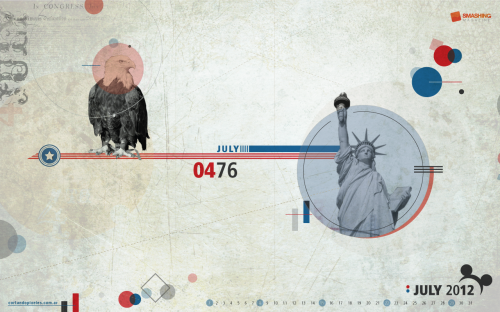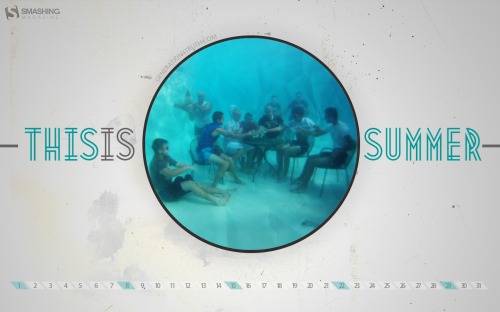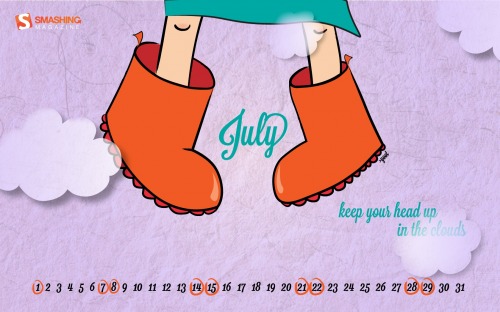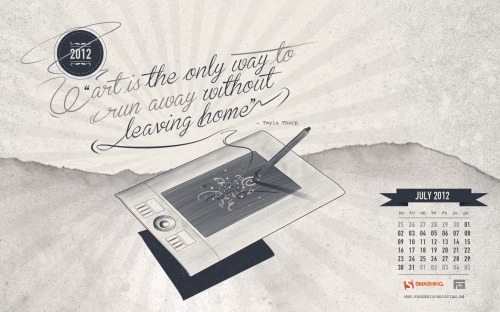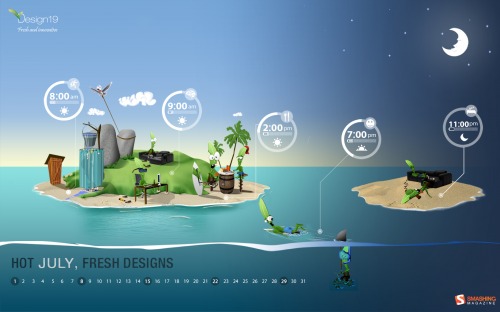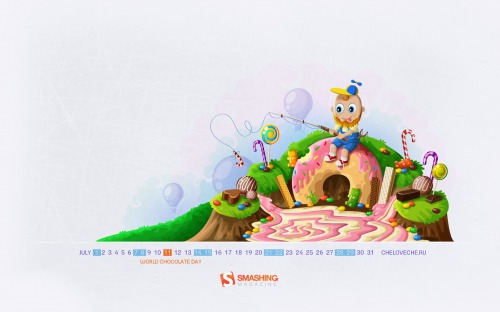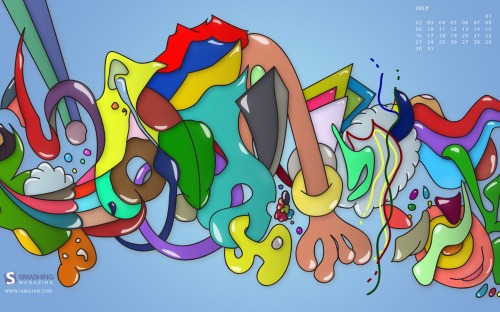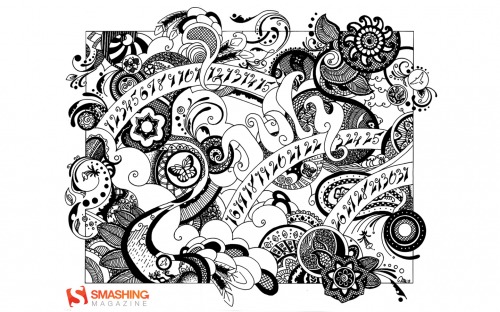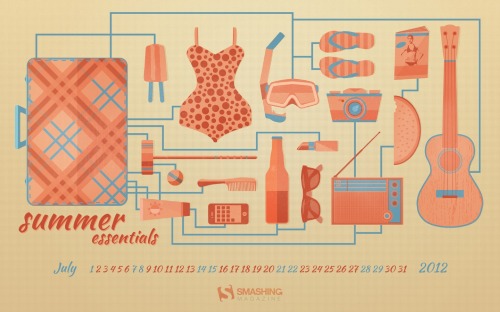We always try our best to challenge your artistic abilities and produce some interesting, beautiful and creative artwork. And as designers we usually turn to different sources of inspiration. As a matter of fact, we’ve discovered the best one—desktop wallpapers that are a little more distinctive than the usual crowd. This creativity mission has been going on for over four years now, and we are very thankful to all designers who have contributed and are still diligently contributing each month.
We continue to nourish you with a monthly spoon of inspiration. This post features free desktop wallpapers created by artists across the globe for July 2012. Both versions with a calendar and without a calendar can be downloaded for free. It’s time to freshen up your wallpaper!
Please note that:
- All images can be clicked on and lead to the preview of the wallpaper,
- You can feature your work in our magazine by taking part in our Desktop Wallpaper Calendar series. We are regularly looking for creative designers and artists to be featured on Smashing Magazine. Are you one of them?
Sun In July
"…enjoy the sun in July!" Designed by Marco Palma from Italy/Germany.
- preview
- with calendar: 1280×800, 1280×1024, 1366×768, 1440×900, 1600×900, 1680×1050, 1920×1200
- without calendar: 1280×800, 1280×1024, 1366×768, 1440×900, 1600×900, 1680×1050, 1920×1200
Bilberry Tiramisu
Designed by Kwestia Smaku from Poland.
- preview
- with calendar: 1024×1024, 1280×800, 1280×1024, 1440×900, 1680×1050, 1920×1080, 1920×1200, 2560×1440
- without calendar: 1024×1024, 1280×800, 1280×1024, 1440×900, 1680×1050, 1920×1080, 1920×1200, 2560×1440
Message In A Bottle
Designed by Pietje Precies from The Netherlands.
- preview
- with calendar: 320×480, 1024×768, 1280×800, 1280×1024, 1440×900, 1680×1050, 1920×1200
- without calendar: 320×480, 1024×768, 1280×800, 1280×1024, 1440×900, 1680×1050, 1920×1200
Blind Duck
"Would you let a blind duck lead you through July?" Designed by Yellow Duck Web Design from Essex, UK.
- preview
- with calendar: 1440×900, 1680×1050, 1920×1080, 1920×1200, 2560×1440
- without calendar: 1440×900, 1680×1050, 1920×1080, 1920×1200, 2560×1440
Jeux Olympiques
"Olympic Games and july 2012 weeks calendar’s infogrpahics." Designed by Sherif Saleh from France.
- preview
- with calendar: 1024×768, 1024×1024, 1280×800, 1280×1024, 1280×768, 1360×768, 1366×768, 1440×900, 1600×900, 1680×1050, 1680×1200
Fourth Of July
Designed by Cortando Pixeles from Argentina.
- preview
- with calendar: 320×480, 640×480, 1024×768, 1024×1024, 1152×864, 1280×800, 1280×960
- without calendar: 320×480, 640×480, 1024×768, 1024×1024, 1152×864, 1280×800, 1280×960
This Is Summer
"Design for 10th anniversary of our youth ministry’ summer camp!" Designed by Lex Valishvili from USA/Russia.
- preview
- with calendar: 800×600, 1280×800, 1440×900, 1600×1200, 1920×1080
- without calendar: 800×600, 1280×800, 1440×900, 1600×1200, 1920×1080
Frisko
Designed by Leen Van Severen from Belgium.
- preview
- with calendar: 1600×1200, 1920×1200, 1920×1440
- without calendar: 1280×800, 1600×1200, 1920×1200, 1920×1440
Cool Summer
"Even tough it is not summer in my country, I made a summer theme. A coolest approach to summer themes, tough, very fresh and “twilighty”." Designed by Marcos Sandrini from Brazil.
- preview
- with calendar: 1024×768, 1280×800, 1280×1024, 1440×900, 1680×1050, 1920×1080, 1920×1200, 2560×1440
- without calendar: 1024×768, 1280×800, 1280×1024, 1440×900, 1680×1050, 1920×1080, 1920×1200, 2560×1440
Sweet Summertime In July
Designed by Anna Downer from USA.
- preview
- with calendar: 320×480, 1024×768, 1024×1024, 1280×800, 1280×1024, 1366×768, 1440×900, 1680×1050, 1680×1050, 1920×1080, 1920×1200
- without calendar: 320×480, 1024×768, 1024×1024, 1280×800, 1280×1024, 1366×768, 1440×900, 1680×1050, 1680×1050, 1920×1080, 1920×1200
Up In The Clouds
Designed by Ioana Bitin (yoot) from Romania.
- preview
- with calendar: 1280×720, 1280×800, 1280×1024, 1366×768, 1440×900, 1600×900, 1680×1050, 1920×1080, 1920×1200, 2560×1440, 2560×1600
- without calendar: 1280×720, 1280×800, 1280×1024, 1366×768, 1440×900, 1600×900, 1680×1050, 1920×1080, 1920×1200, 2560×1440, 2560×1600
Art Is..
"A personal illustration for my new website and corporate identity i descide to share as free wallpaper! Hope you like it!www.fredericchristian.dewww.facebook.com/fredericchristianart." Designed by Frederic Christian from Germany.
- preview
- with calendar: 1280×800, 1280×1024, 1366×768, 1440×900, 1600×1200, 1680×1050, 1920×1080, 1920×1200
- without calendar: 1280×800, 1280×1024, 1366×768, 1440×900, 1600×1200, 1680×1050, 1920×1080, 1920×1200
Summertime Picnic
"Ants enjoying a summertime feast." Designed by Tommy Digiovanni from USA.
- preview
- with calendar: 320×480, 1024×768, 1024×1024, 1280×720, 1280×800, 1280×1024, 1366×768, 1680×1050, 1920×1080, 1920×1200
- without calendar: 320×480, 1024×768, 1024×1024, 1280×720, 1280×800, 1280×1024, 1366×768, 1680×1050, 1920×1080, 1920×1200
Do Zen
"The year is more than half-way through and this is a reminder to live life, be adventurist, and take a breather. Whatever the challenge is, Doers make it happen — they always find a way." Designed by Richard Hanley Jr. from USA.
- preview
- with calendar: 1024×768, 1280×1024, 1600×1200, 1920×1200, 2560×1440
- without calendar: 1024×768, 1280×1024, 1600×1200, 1920×1200, 2560×1440
Hot July
Designed by Design19 from Romania.
- preview
- with calendar: 320×480, 1024×1024, 1280×800, 1280×1024, 1366×768, 1440×900, 1680×1050, 1920×1080, 1920×1200
- without calendar: 320×480, 1024×1024, 1280×800, 1280×1024, 1366×768, 1440×900, 1680×1050, 1920×1080, 1920×1200
Splash Dance
"Most Flamenco dances are fiery, passionate affairs, this one however is a bit soggy…" Designed by James-n-osborne from United Kingdom.
- preview
- with calendar: 320×480, 640×480, 1024×768, 1024×1024, 1280×800, 1280×1024, 1440×900, 1600×1200, 1680×1050, 1920×1080, 1920×1200, 2560×1440
- without calendar: 320×480, 640×480, 1024×768, 1024×1024, 1280×800, 1280×1024, 1440×900, 1600×1200, 1680×1050, 1920×1080, 1920×1200, 2560×1440
Vintage Olympic Poster
Designed by Davide Vicariotto from Italy.
- preview
- with calendar: 1024×768, 1024×1024, 1280×720, 1280×800, 1280×960, 1280×1024, 1400×1050, 1440×900, 1600×1200, 1680×1050, 1920×1080, 1920×1200, 1920×1440, 2048×2048
Original Thirteen
"A throwback to the original United States Flag in honor of the 236th birthday of the nation." Designed by Geoffrey Sagers from USA.
- preview
- with calendar: 320×480, 1024×1024, 1280×1024, 1366×768, 1440×900, 1680×1050, 1920×1080
- without calendar: 320×480, 1024×1024, 1280×1024, 1366×768, 1440×900, 1680×1050, 1920×1080
World Chocolate Day
Designed by Cheloveche.ru from Russia.
- preview
- with calendar: 1024×768, 1280×800, 1280×1024, 1440×900, 1680×1050, 1920×1200
- without calendar: 395×512, 1024×768, 1280×800, 1280×1024, 1440×900, 1680×1050, 1920×1200
Cracked
Designed by Agata MaciÄ…gowska from Poland.
- preview
- with calendar: 1024×768, 1280×800, 1280×1024, 1440×900, 1680×1050, 1920×1080, 1920×1200
- without calendar: 1024×768, 1280×800, 1280×1024, 1440×900, 1680×1050, 1920×1080, 1920×1200
Floral Thing
"Wallpaper which I created consists of my personal sketches of Polish herbs and flowers and custom typography. I wanted it to be light and simple with a hint of romantic feeling. I hope you’ll enjoy it!" Designed by Beata Kurek from Poland.
- preview
- with calendar: 1024×1024, 1280×800, 1440×900, 1680×1050, 2560×1440
- without calendar: 1024×1024, 1280×800, 1440×900, 1680×1050, 2560×1440
Summer
Designed by Ajan Navaratnasingam from London, UK.
- preview
- with calendar: 1024×768, 1024×1024, 1280×800, 1280×1024, 1440×900, 1600×1200, 1600×1050, 1920×1080, 1920×1200
- without calendar: 1024×768, 1024×1024, 1280×800, 1280×1024, 1440×900, 1600×1200, 1600×1050, 1920×1080, 1920×1200
Birdie Nam Nam
"I have created a pattern that has a summer feeling. For me July and summer is bright color, joy and lots of different flowers and birds. So naturally i incorporated all these elements in a crazy pattern." Designed by Lina Karlsson, Idadesign Ab from Sweden.
- preview
- with calendar: 320×480, 1024×768, 1280×1024, 1440×900, 1680×1050, 1920×1200, 2560×1440
- without calendar: 320×480, 1024×768, 1280×1024, 1440×900, 1680×1050, 1920×1200, 2560×1440
Inspired By Henna
"I wanted to bring the organic, flowing art of henna to the digital world." Designed by Tara M Baker from USA.
Jump Into Summer
"This is photography of my dog who is jumping into lake on our short vacation." Designed by Agencja Reklamowa Kalisz from Poland.
- preview
- with calendar: 320×480, 1024×1024, 1280×800, 1366×768, 1680×1050, 1920×1080
- without calendar: 320×480, 1024×1024, 1280×800, 1366×768, 1680×1050, 1920×1080
Summer Essentials
"A few essential items for the summertime weather at the beach, park, and everywhere in-between." Designed by Zach Vandehey from USA.
- preview
- with calendar: 1024×768, 1440×900, 1600×1200, 1920×1200, 2560×1440
- without calendar: 1024×768, 1440×900, 1600×1200, 1920×1200, 2560×1440
Join In Next Month!
Please note that we respect and carefully consider the ideas and motivation behind each and every artist’s work. This is why we give all artists the full freedom to explore their creativity and express emotions and experience throughout their works. This is also why the themes of the wallpapers weren’t anyhow influenced by us, but rather designed from scratch by the artists themselves.
A big thank you to all designers for their participation. Join in next month!
What’s Your Favourite?
What’s your favorite theme or wallpaper for this month? Please let us know in the comment section below.
Stay creative and keep on smashing!
(vf)
© Smashing Editorial for Smashing Magazine, 2012.





